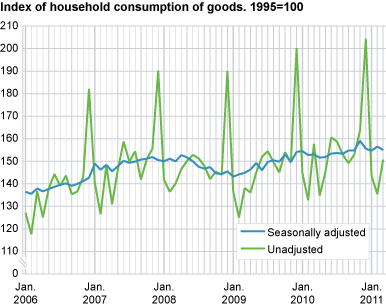Content
Published:
This is an archived release.
Weak trend in households’ consumption of goods
Seasonally-adjusted figures show that household consumption of goods was down 1 per cent from February to March, after a sharp rise in February. Excluding food and beverages, there was a general decline in household consumption.
Consumption of food, beverages and tobacco rose by 0.9 per cent from February to March, after falling the previous month.
The largest decrease was the purchase of vehicles and petrol, which showed a decline of 4.6 per cent from February to March. The decline comes after strong growth the previous month.
Household consumption of electricity and heating fuels showed a moderate decline of 0.4 per cent in March, while consumption of other goods fell by 1 per cent.
|
It is important to be aware that the uncertainty in the seasonally-adjusted indices for March and April is greater than normal due to the changed placing of Easter. The seasonally-adjusted indices take the placing of Easter into account, but it can still be difficult to adjust for all impacts caused by Easter. |
Without adjustments for seasonal variations, the household consumption of goods was 4.4 per cent lower in March 2011 compared with March 2010.
| Period | Sesonally adjusted |
Change from
previous month. Per cent |
Unadjusted |
Change from
the same month last year. Per cent |
|||||||||||||||||||||||||||||||||||||||||||||||||||||||||||||||||||||||||||
|---|---|---|---|---|---|---|---|---|---|---|---|---|---|---|---|---|---|---|---|---|---|---|---|---|---|---|---|---|---|---|---|---|---|---|---|---|---|---|---|---|---|---|---|---|---|---|---|---|---|---|---|---|---|---|---|---|---|---|---|---|---|---|---|---|---|---|---|---|---|---|---|---|---|---|---|---|---|---|---|
| 2010 | |||||||||||||||||||||||||||||||||||||||||||||||||||||||||||||||||||||||||||||||
| March | 153.1 | 0.2 | 157.7 | 14.2 | |||||||||||||||||||||||||||||||||||||||||||||||||||||||||||||||||||||||||||
| April | 151.6 | -1.0 | 134.8 | -1.0 | |||||||||||||||||||||||||||||||||||||||||||||||||||||||||||||||||||||||||||
| May | 151.9 | 0.2 | 145.3 | 0.2 | |||||||||||||||||||||||||||||||||||||||||||||||||||||||||||||||||||||||||||
| June | 153.4 | 1.0 | 160.6 | 5.7 | |||||||||||||||||||||||||||||||||||||||||||||||||||||||||||||||||||||||||||
| July | 153.7 | 0.2 | 158.8 | 2.8 | |||||||||||||||||||||||||||||||||||||||||||||||||||||||||||||||||||||||||||
| August | 153.3 | -0.3 | 153.0 | 2.3 | |||||||||||||||||||||||||||||||||||||||||||||||||||||||||||||||||||||||||||
| September | 154.8 | 1.0 | 149.2 | 2.8 | |||||||||||||||||||||||||||||||||||||||||||||||||||||||||||||||||||||||||||
| October | 154.8 | 0.0 | 153.0 | -0.7 | |||||||||||||||||||||||||||||||||||||||||||||||||||||||||||||||||||||||||||
| November | 159.1 | 2.8 | 163.6 | 9.5 | |||||||||||||||||||||||||||||||||||||||||||||||||||||||||||||||||||||||||||
| December | 155.6 | -2.2 | 204.4 | 2.1 | |||||||||||||||||||||||||||||||||||||||||||||||||||||||||||||||||||||||||||
| 2011 | |||||||||||||||||||||||||||||||||||||||||||||||||||||||||||||||||||||||||||||||
| January | 154.7 | -0.6 | 143.4 | -1.0 | |||||||||||||||||||||||||||||||||||||||||||||||||||||||||||||||||||||||||||
| February | 156.5 | 1.2 | 135.4 | 2.1 | |||||||||||||||||||||||||||||||||||||||||||||||||||||||||||||||||||||||||||
| March | 155.0 | -1.0 | 150.7 | -4.4 | |||||||||||||||||||||||||||||||||||||||||||||||||||||||||||||||||||||||||||
| 1 | Please note that the indices have been revised. |
Method differs from the index of retail salesThe index of household consumption of goods describes the development in household consumption, while the index of retail sales measures the development in retail sales. Compared to the index of retail sales, the index of household consumption of goods has a wider selection of goods. The calculation of the index of household consumption of goods is based on information from the index of retail sales, plus purchases of cars (initial registration) and consumption of electricity and heating fuels. This may result in deviations in the development of the two indices. Additionally, it should be borne in mind that the “Standard Industrial Classification” changed on 1 January 2009, which inter alia means that petrol stations from then onwards are part of retail sales. |
Connection to quarterly national accountsThe index of household consumption of goods uses the same definitions and methods of compilation as the quarterly national accounts, and thus serves as an indicator of household consumption in the quarterly national accounts. |
RevisionsSince Statistics Norway gives a high priority to timeliness in the release of statistics, the index of household consumption of goods sometimes has to rely on preliminary estimates, which are replaced in subsequent releases. |
Seasonally-adjusted figuresAs regards the seasonally-adjusted figures, the figures for previous periods may be revised when a new month is added to the series. For further information, see About seasonal adjustments in the left column. |
Contact
-
Vemund Rundberget
E-mail: uve@ssb.no
tel.: (+47) 97 65 50 90

